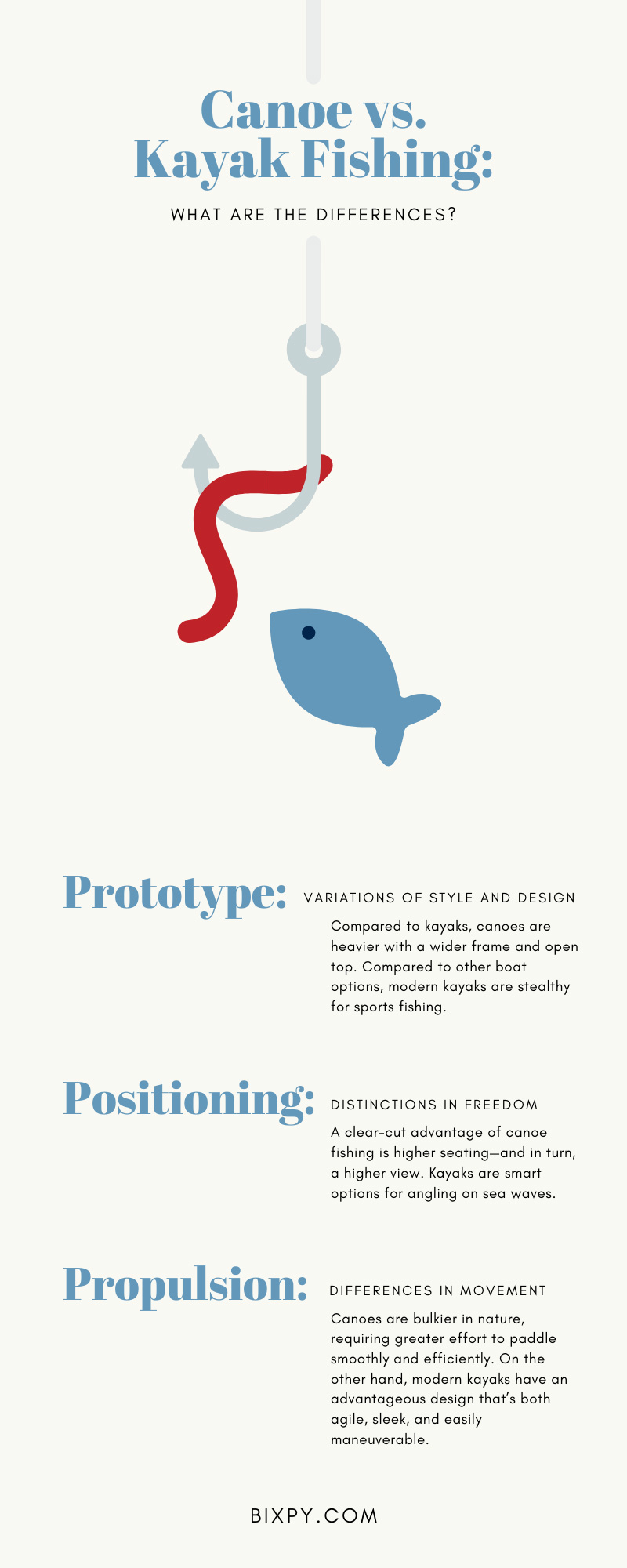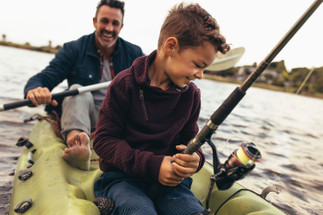Posted by Bixpy on Sep 13th 2021
Canoe vs. Kayak Fishing: What Are the Differences?
Language is full of complexities and eccentricities—and English is no exception to this nightmare-esque rule. We’re not talking about the geographical pop vs. soda vs. coke debates, either. Our modern-day thesaurus exists to define similar words and outline common terms, but not every name or label we use is interchangeably correct.
People may believe that jam and jelly are synonymous in nature, but these types of fruity spreads are surely not the same. Neither are shrimp and prawns, crocodiles and alligators, or concrete and cement. Our world is full of commonly confused things—and in the world of aquatic sport, canoes and kayaks are one of these signature bewilderments. These two human-powered vessels are not identically buoyant twins.
A plethora of tangible distinctions exists between canoes and kayaks—in boat design, gear, and even the backdrop of their relevant history in culture and society. Factually, both watercraft vessels have been around town for centuries. Yet, they hold more dissimilarities in form and function than common likenesses. When considering what the differences are between these waterborne vessels, you must include canoe vs. kayak fishing. Let’s examine closer which craft may better suit your angling ventures.
Prototype: Variations of Style and Design
Canoeing vs. kayaking is an age-old debate, and not one individual can settle the opposing argument easily. Canoes and kayaks are equally timeless options for enjoyable fishing. Each type of boat offers a slew of merits due to the function of its particular design.
Canoe Construction
Native Americans originated canoes as narrow watercraft vessels centuries ago. Modern-day canoes are lightweight, highly durable, and typically designed to carry more than a single person. One person tends to sit at the bow to paddle, while another sits at the stern to steer. Their small-sized nature is ideal for maneuvering on ponds, lakes, and rivers, especially in remote locations. Compared to kayaks, canoes are heavier with a wider frame and open top.
Seating arrangements are relatively comfortable, with a fair amount of room for fishing gear. Do keep in mind that fishing on a canoe takes either 1) more skill as a solo act or 2) more people for greater success. Without controlled experience, fighting or reeling in a fish can create an imbalance and cause a man-overboard situation. Calm waters are key for greater stability.
Kayak Structure
Arctic Indigenous tribes also created and utilized kayaks thousands of years ago for hunting expeditions. The framework of a kayak differs from a canoe due to its traditional one-person, closed-cockpit design. Since kayaks are usually smaller and thinner than canoes, kayaking aficionados consider them sleekier for enhanced speed. The slightly curved upward bow and stern create less resistance while paddling.
Kayaks tend to be far more versatile in design as well. Various options are available on the market to suit personal needs, such as racing, leisure, touring, and extreme whitewater sports. Specialized designs exist for fishing to offer greater stability while casting and reeling. Compared to other boat options, modern kayaks are stealthy for sports fishing.
Positioning: Distinctions in Freedom
What are the differences between canoe vs. kayak fishing? Fishing from a canoe vs. a kayak also offers varying levels of comfort and positioning techniques in the water. When considering between these contending options, an angler must think about their center of gravity. Not to mention, anglers must also consider features of their primary fishing locations, such as saltwater, freshwater, cover, and shorelines.
Canoe Positioning
A clear-cut advantage of canoe fishing is higher seating—and in turn, a higher view. Greater height overlooking the water provides a wider viewpoint of any fish swimming near or under your craft. Yet, you only have your arms and shoulders for fishing techniques. Consider your water-based position as well, as anchoring can be tricky. You need a reliable anchor to stay steady while casting in the wind.
Kayak Positioning
A kayak certainly sits lower, meaning an angler is closer to the water than paddling from a canoe. Ergo, this enclosed, lower-gravity seating provides superior stability when fishing in less-than-calm waters. If fishing conditions aren’t the most favorable, anglers can still head out for a prized catch in more challenging locations. Kayaks are smart options for angling on sea waves.
However, keep in mind that you can only face forward on a traditional kayak. You’re much closer to the water’s surface as well—and must learn how to use less of your body for casting and reeling when a fish strikes. Newer sit-on-top models offer possibilities for standup fishing with wider beams, open flat decks, and elevated seating platforms.
Propulsion: Differences in Movement
An essential deliberation consideration in the canoe vs. kayak debate has to be propulsion. Once again, each craft differs by paddle design. A common misconception is that canoes use oars and kayaks use paddles. As a matter of fact, both crafts propel forward from users pushing water forward with paddles.
Canoe Propulsion
Canoes are bulkier in nature, requiring greater effort to paddle smoothly and efficiently. Their single-blade paddle design also plays into this learning curve of moving from one side to another. Maintaining control is no easy feat, which is why two-manned paddling is better for stable movement and opportunities of angling success.
Kayak Propulsion
On the other hand, modern kayaks have an advantageous design that’s both agile, sleek, and easily maneuverable. Due to their double-bladed design, each stroke boosts the efficiency from one side to the other. As their paddle blades are offset at a 90-degree angle from one another, positioning is far simpler to cut down resistance and track straight ahead.
Many anglers prefer solo kayaks due to their versatile freedom and reliable steerage. The straightforward propulsion of kayaks helps anglers get right where they need to be. Opportune fishing locations await.
Fishing Success: Personal Watercraft Motorization
Water enthusiasts should consider the assorted advantages of kayak fishing vs. canoe fishing for the best fishing experiences. Either way, an angler can’t go wrong with motorizing a personal watercraft with an efficient jet propulsion system for apex speed and ease.
Bixpy’s J-2 Outboard Kit offers a lightweight outboard motor and battery to power any canoe or kayak on the market. This ultra-light package is perfect for long days of stealthy, enjoyable fishing at your favorite or unexplored locations. Read more about our motor’s valuable features on our site or watch the product video today.




